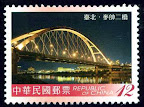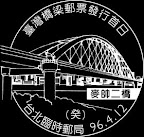
Stamp Issue : 1978-11-01
Situated in Jiuxigou in Fengdu County, Sichuan Province, Jiuxigou Bridge is a highway bridge. Straddling 116 meters on a single span and with a width of 7.5 meters, the bridge was completed in 1972 and was the world's largest single-arch stone bridge at the time. The main arch is variable-section catenary, with the vault 1.6 meters thick, bottom arch 2.25 meters thick amd arch vector degrees 1/8. The masonry construction was done ring by ring in the scaffolding.
九溪溝橋位於四川省豐都縣九溪溝的公路橋,跨徑為116公尺,建成時是世界上跨徑最大的石拱橋,於1972年建成。橋寬7.5公尺,主拱圈為變截面懸鏈線,拱頂厚1.6公尺,拱腳厚2.25公尺,拱矢度1/8。施工方法是在腳手架上分圈砌築。














